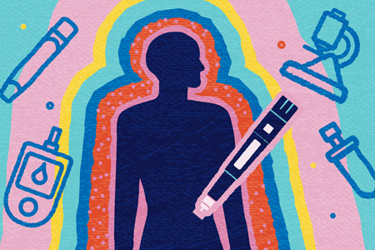Lessons Learned From Vivani Medical's Study Of GLP-1 Implant
A conversation with Vivani Medical Cofounder and CEO Adam Mendelsohn, Ph.D.

Amid a sea of injectables for the administration of GLP-1 agonists, rises a newer administration method: subdermal implants. One such implant is being studied by Vivani Medical, who opted for the delivery method after its founders developed a titania nanoporous membrane, now called NanoPortal, to (at the time) deliver interferon-alpha for the treatment of hepatitis C. Now that Gilead’s Sovaldi became available and replaced interferon-alpha as the standard of care treatment for hepatitis C, the founders are exploring other uses for the device, which is now slated to deliver exenatide in the company’s LIBERATE-1 trial.
In this Q&A, Vivani Medical Cofounder and CEO Adam Mendelsohn, Ph.D. discusses the company’s first application of the NanoPortal, including its approach upsides for patient adherence, its optimized trial design, and its reception among research sites and their patients.
One upside of the NanoPortal subdermal implant (paired with exenatide) is that it enables twice-yearly administration as opposed to the daily and weekly administrations (injectable and oral) for other GLP-1s. In addition to the potential for improving medication adherence in clinical care, how can this administration method and frequency positively impact trial veracity?
By removing the human element from drug administration, NanoPortal implant technology largely eliminates the effect of variables such as timing of doses and medication adherence on assessing drug efficacy and safety. In addition, we anticipate greater real-world translation of clinical trial results with NanoPortal implants compared to any other modality that requires frequent administration such as a daily pill or a weekly injectable. Medication adherence is typically significantly better in a clinical setting than in the real world, resulting in real-world patients not receiving the full potential benefits that the drugs have clinically proven they can provide. We hope that NanoPortal will change that paradigm, unleashing a drug’s true potential for all real-world patients, and not just the ~50% who adhere to prescribing recommendations.
The LIBERATE-1 trial also includes an active control arm with Bydureon BCise (injectable exenatide) and a second active control arm with Wegovy (semaglutide injection). What significance does the trial design have in determining the safety, tolerability, and pharmacokinetics of the exenatide implant?
Each control arm has a specific purpose in the trial design. Bydureon BCise is the only exenatide product on the market with a proven safety record in terms of outcomes such as major adverse cardiovascular events and acute kidney injury. The major safety-related concern of GLP-1 agonists is intra-patient short timescale fluctuations in drug exposure, because rapid increases in exposure can lead to the gastrointestinal side effects that represent the largest complaints associated with GLP-1 drugs in general. Gastrointestinal side effects can lead to dehydration, which if not addressed can lead to hypovolemia and ultimately acute kidney injury. A robust PK sampling plan is in place to obtain intra-patient short timescale drug exposure fluctuations between the exenatide implant NPM-115 and Bydureon BCise. This then determines whether NPM-115 is associated with intra-patient drug exposure fluctuations that are consistent with, or possibly smaller, than the exenatide product with a proven safety record, Bydureon BCise. We anticipate that demonstrating small fluctuations will be important to the overall approval of NPM-115 which may utilize a 505(b)(2) pathway referencing the safety database associated with Bydureon. In addition, the Bydureon BCise cohort will enable us to benchmark the exenatide exposure level achieved with the particular dose of exenatide delivered from NPM-115 in LIBERATE-1 with Bydureon BCise using the same analytical methods in the same study. This result will help inform the doses to be evaluated in subsequent clinical development of NPM-115.
We included Wegovy (semaglutide injection) to provide context to any tolerability observations that may occur with NPM-115. All subjects in the study will be run-in on semaglutide for eight weeks — four weeks on 0.25 mg/week and four weeks on 0.5 mg/week. The next step in the standard titration for Wegovy would be 1 mg/week. All subjects will be randomized to the three groups after 8 weeks when each subject would otherwise have received semaglutide 1 mg/week. We anticipate the GLP-1 activity associated with the NPM-115 dose used in LIBERATE-1 will be comparable to the semaglutide activity associated with Wegovy 1 mg/week. While some patients in NPM-115 may experience tolerability events, including semaglutide 1 mg/week will allow us to understand whether these events are consistent with the standard of care treatment. Furthermore, this design will allow us to understand whether the week-to-week fluctuations that occur with Wegovy after the first week of treatment at this dose are associated with any difference in occurrence of tolerability events than with NPM-115. For the latter, we anticipate it will only experience a single rise in exposure at the time of implantation.
Tell us about the decision to run the LIBERATE-1 trial at two clinical research sites in Australia. What about the sites — their locations, PIs, patient populations, etc. — were attractive for this study?
We decided to conduct the study in Australia because many clinical sites are capable of generating high-quality data that adhere to ICH guidelines for clinical studies. This enables us to use the data in FDA submissions. Also, the Australian government offers a 43% rebate for a significant amount of the expenses that we expect to be eligible. The specific sites within Australia were selected after a thorough evaluation including access to eligible subjects, capability to conduct the study including the domiciling needed for the robust PK sampling plan, and quality of the PIs.
What has the reception among providers and patients been to enrolling in this trial?
The reception among providers and patients has been very enthusiastic. Enrollment has been proceeding very well, and we continue to expect to have top-line data by mid-year 2025.
Given the current GLP-1 market, both timeliness and accuracy in the clinical phase are essential to gaining approval and, hopefully, finding success in the marketplace. During the clinical phase, what are some best practices or strategies you’ve employed to ensure the company and the trial balance safety, efficacy, and pace?
Before initiating the study, we did a robust feasibility process to choose high-quality sites with the ability to enroll the subjects in a timely manner. We chose two sites rather than one for efficient enrollment. As far as safety, the study was designed with substantial FDA input and the protocol, informed consent, and investigator’s brochure were thoroughly reviewed by the ethics board. In addition, we adhere to GCP.
We continually re-evaluate the commercial target product profile based on what we observe in the competitive landscape, and we do our best to optimize trial design to provide the most useful and actionable data in the most time- and cost-efficient manner. Our leadership team meets on a weekly basis to discuss these issues, and we have longer strategic meetings a few times a year sometimes in an off-site setting. We also have had, and intend to continue to have, frequent engagement with the FDA to optimize our clinical development program as we proceed. I expect that we will learn a lot along the way, but we have a truly outstanding team behind this program and we appear to currently be the leader in developing a six-month or longer GLP-1 implant.
About The Expert:
 Adam Mendelsohn, Ph.D., is the co-founder and CEO of Vivani Medical and has been on its Board since August 2022 after the merger. Before this, he co-founded Nano Precision Medical and served as its chairman and CEO since 2011. Dr. Mendelsohn earned a Ph.D. in bioengineering from the UC San Francisco/UC Berkeley Joint Graduate Group in 2011. His accolades include an NSF fellowship for research at Kyoto University and published work on Type 1 diabetes treatments. He directed the Venture Innovation Program in Life Sciences and received a Management of Technology certificate from Haas School of Business. Additionally, Dr. Mendelsohn has been a technical advisor to the Alfred E. Mann Institute, a fellow of the Startup Leadership Program, president of UCSF’s Graduate Division Alumni Association, and currently serves on the Maestro Foundation board.
Adam Mendelsohn, Ph.D., is the co-founder and CEO of Vivani Medical and has been on its Board since August 2022 after the merger. Before this, he co-founded Nano Precision Medical and served as its chairman and CEO since 2011. Dr. Mendelsohn earned a Ph.D. in bioengineering from the UC San Francisco/UC Berkeley Joint Graduate Group in 2011. His accolades include an NSF fellowship for research at Kyoto University and published work on Type 1 diabetes treatments. He directed the Venture Innovation Program in Life Sciences and received a Management of Technology certificate from Haas School of Business. Additionally, Dr. Mendelsohn has been a technical advisor to the Alfred E. Mann Institute, a fellow of the Startup Leadership Program, president of UCSF’s Graduate Division Alumni Association, and currently serves on the Maestro Foundation board.
